Portable Arduino-Based Multi-Sensor Device (SBEDAD): Measuring the Built Environment in Street Cycling Spaces
Abstract
1. Introduction
2. System Requirements and Design
2.1. Basis of the System Design
2.2. Low Cost
2.3. Open-Source Software
3. Functional Validation
3.1. GPS and BDS Longitude and Latitude
3.2. Environmental Temperature and Relative Humidity
- Hairdryer heated blowing mode;
- Hairdryer cool blowing mode;
- Ice-water mode;
- Breathe warm air mode.
3.3. Air Pollution of PM1, PM2.5, and PM10
3.4. Illumination
3.5. Environmental Noise Intensity
4. Field Measurement Results
4.1. Field Data Acquisition Process and Results
4.2. Fusing Data to Understand Cities
5. Conclusions and Future Work
Author Contributions
Funding
Data Availability Statement
Conflicts of Interest
References
- Llaguno-Munitxa, M.; Bou-Zeid, E. Mobile Urban Sensing Technologies (MUST) for High Spatial Resolution Urban Environmental Mapping. In Proceedings of the 2020 Digital FUTURES; Springer: Singapore, 2021; pp. 124–133. [Google Scholar] [CrossRef]
- Bibri, S.E.; Krogstie, J. A Novel Model for Data-Driven Smart Sustainable Cities of the Future: A Strategic Roadmap to Transformational Change in the Era of Big Data. Future Cities Environ. 2021, 7, 2–37. [Google Scholar] [CrossRef]
- Ganji, A.; Youssefi, O.; Xu, J.; Mallinen, K.; Lloyd, M.; Wang, A.; Bakhtari, A.; Weichenthal, S.; Hatzopoulou, M. Design, Calibration, and Testing of a Mobile Sensor System for Air Pollution and Built Environment Data Collection: The Urban Scanner Platform. Environ. Pollut. 2022, 317, 120720. [Google Scholar] [CrossRef] [PubMed]
- Noseir, D.; Khalifa, M.; Serag, Y.; El Fayoumi, M.A. Open-Data and Data Acquisition for Smart Cities and Urban Mobility Studies: Potential Approaches and Current Challenges. IJSBAR 2023, 69, 1–15. [Google Scholar]
- Jia, F. Neural Network Model of Urban Landscape Design Based on Multi-Target Detection. Comput. Intell. Neurosci. 2022, 2022, 9383273. [Google Scholar] [CrossRef] [PubMed]
- Maider, M.; Bou-Zeid, E.; Bogosian, B.; Al Tair, A.; Radcliff, D.; Fisher, S.; Ryu, Y. Sensing and Information Technologies for the Environment (SITE): Hardware and Software Innovations in Mobile Sensing Technologies. In Proceedings of the International Building Physics Conference, Syracuse, NY, USA, 23–26 September 2018; Volume 9, p. 24. [Google Scholar]
- Portella, A.A. Built Environment. In Encyclopedia of Quality of Life and Well-Being Research, 2nd ed.; Michalos, A.C., Ed.; Springer: Dordrecht, The Netherlands, 2014. [Google Scholar] [CrossRef]
- Handy, S.L.; Boarnet, M.G.; Ewing, R.; Killingsworth, R.E. How the Built Environment Affects Physical Activity: Views from Urban Planning. Am. J. Prev. Med. 2002, 23 (Suppl. S2), 64–73. [Google Scholar] [CrossRef] [PubMed]
- Nouman, A.S.; Chokhachian, A.; Santucci, D.; Auer, T. Prototyping of Environmental Kit for Georeferenced Transient Outdoor Comfort Assessment. ISPRS Int. J. Geo-Inf. 2019, 8, 76. [Google Scholar] [CrossRef]
- Apte, J.S.; Messier, K.P.; Gani, S.; Brauer, M.; Kirchstetter, T.W.; Lunden, M.M.; Marshall, J.D.; Portier, C.J.; Vermeulen, R.C.; Hamburg, S.P. High-Resolution Air Pollution Mapping with Google Street View Cars: Exploiting Big Data. Environ. Sci. Technol. 2017, 51, 6999–7008. [Google Scholar] [CrossRef] [PubMed]
- Tsoka, S.; Tsikaloudaki, K.; Theodosiou, T.; Bikas, D. Urban Warming and Cities’ Microclimates: Investigation Methods and Mitigation Strategies—A Review. Energies 2020, 13, 1414. [Google Scholar] [CrossRef]
- Behzadfar, M.; Faizi, M.; Asl, S.R.; Beiklou, B.H. A New Collaborative Pattern between Landscape Architects and Urban Designers in Environmental Design. Am. J. Environ. Sci. 2010, 6, 344–349. [Google Scholar] [CrossRef][Green Version]
- Nguyen, H.-T.; Lee, Y.; Ahn, J.; Han, T.H.; Park, J.K. A Low-Cost Lightweight Deflectometer with an Arduino-Based Signal Interpretation Kit to Evaluate Soil Modulus. Sensors 2023, 23, 9710. [Google Scholar] [CrossRef] [PubMed]
- Cannistraro, M.; Cao, J.; Ponterio, L. New Technique Monitoring and Transmission Environmental Data with Mobile Systems. Instrum. Mes. Métrologie 2018, 18, 549–562. [Google Scholar] [CrossRef]
- Ottaviano, M.; Beltrán Jaunsarás, M.; Terius-Padron, J. Empowering Citizens through Perceptual Sensing of Urban Environmental and Health Data following a Participative Citizen Science Approach. Sensors 2019, 19, 2940. [Google Scholar] [CrossRef] [PubMed]
- Nagata, S.; Nakaya, T.; Hanibuchi, T.; Amagasa, S.; Kikuchi, H.; Inoue, S. Objective Scoring of Streetscape Walkability Related to Leisure Walking: Statistical Modeling Approach with Semantic Segmentation of Google Street View Images. Health Place 2020, 66, 102428. [Google Scholar] [CrossRef] [PubMed]
- Najafizadeh, L.; Froehlich, J.E. A Feasibility Study of Using Google Street View and Computer Vision to Track the Evolution of Urban Accessibility. In Proceedings of the 20th International ACM SIGACCESS Conference on Computers and Accessibility, Galway, Ireland, 22–24 October 2018; Association for Computing Machinery: New York, NY, USA, 2018; pp. 340–342. [Google Scholar] [CrossRef]
- Vinci, B.; Tonacci, A.; Caudai, C.; Rosa, P.; Nencini, L.; Pratali, L. The Senseable Pisa Project: Citizen-Participation in Monitoring Acoustic Climate of Mediterranean City Centers. Clean-Soil Air Water 2017, 45, 1600137. [Google Scholar] [CrossRef]
- Gu, P.; Han, Z.; Cao, Z.; Chen, Y.; Jiang, Y. Using Open Source Data to Measure Street Walkability and Bikeability in China: A Case of Four Cities. Transp. Res. Rec. 2018, 2672, 63–75. [Google Scholar] [CrossRef]
- Ye, Y.; Richards, D.; Lu, Y.; Song, X.; Zhuang, Y.; Zeng, W.; Zhong, T. Measuring Daily Accessed Street Greenery: A Human-Scale Approach for Informing Better Urban Planning Practices. Landsc. Urban Plan. 2019, 191, 103434. [Google Scholar] [CrossRef]
- Ito, K.; Biljecki, F. Assessing Bikeability with Street View Imagery and Computer Vision. Transp. Res. Part C 2021, 132, 103371. [Google Scholar] [CrossRef]
- Zhang, Y.; Zhao, H.; Li, Y.; Long, Y.; Liang, W. Predicting Highly Dynamic Traffic Noise Using Rotating Mobile Monitoring and Machine Learning Method. Environ. Res. 2023, 229, 115896. [Google Scholar] [CrossRef]
- Anguelov, D.; Dulong, C.; Filip, D.; Frueh, C.; Lafon, S.; Lyon, R.; Ogale, A.; Vincent, L.; Weaver, J. Google Street View: Capturing the World at Street Level. Computer 2010, 43, 32–38. [Google Scholar] [CrossRef]
- Li, X.; Ratti, C. Using Google Street View for Street-Level Urban Form Analysis, a Case Study in Cambridge, Massachusetts. In The Mathematics of Urban Morphology; D’Acci, L., Ed.; Springer International Publishing: Cham, Switzerland, 2019; pp. 457–470. [Google Scholar] [CrossRef]
- Costa, R.; Resende, R.; Fernandes, S. Urban Data Collectors: A Pragmatic Approach to Leveraging Urban Sensing. In Proceedings of the 2015 IFIP/IEEE International Symposium on Integrated Network Management (IM), Ottawa, ON, Canada, 11–15 May 2015; IEEE: Piscataway, NJ, USA, 2015; pp. 886–889. [Google Scholar]
- Kabisch, N.; Selsam, P.; Kirsten, T.; Lausch, A.; Bumberger, J. A Multi-sensor and Multi-temporal Remote Sensing Approach to Detect Land Cover Change Dynamics in Heterogeneous Urban Landscapes. Ecol. Indic. 2018, 99, 273–282. [Google Scholar] [CrossRef]
- Campbell, A.T.; Eisenman, S.B.; Lane, N.D.; Miluzzo, E.; Peterson, R.A. People-Centric Urban Sensing. In Proceedings of the 2nd Annual International Workshop on Wireless Internet, Boston, MA, USA, 2 August 2006. [Google Scholar] [CrossRef]
- Zhou, D.; Xiao, J.; Bonafoni, S.; Berger, C.; Deilami, K.; Zhou, Y.; Frolking, S.; Yao, R.; Qiao, Z.; Sobrino, J.A. Satellite Remote Sensing of Surface Urban Heat Islands: Progress, Challenges, and Perspectives. Remote Sens. 2019, 11, 48. [Google Scholar] [CrossRef]
- Lynch, J.P.; Kenneth, J.L. A Summary Review of Wireless Sensors and Sensor Networks for Structural Health Monitoring. Shock. Vib. Dig. 2006, 38, 91–130. [Google Scholar] [CrossRef]
- Zanella, A.; Bui, N.; Castellani, A.; Vangelista, L.; Zorzi, M. Internet of Things for Smart Cities. IEEE Internet Things J. 2014, 1, 22–32. [Google Scholar] [CrossRef]
- Cardone, G.; Bellavista, P.; Corradi, A.; Foschini, L. Effective Collaborative Monitoring in Smart Cities: Converging MANET and WSN for Fast Data Collection. In Proceedings of the Kaleidoscope 2011: K-2011, Proceedings of ITU, Cape Town, South Africa, 12–14 December 2011; pp. 1–8. [Google Scholar]
- Sideris, N.; Bardis, G.; Voulodimos, A.; Miaoulis, G.; Ghazanfarpour, D. Enhancing Urban Data Analysis: Leveraging Graph-Based Convolutional Neural Networks for a Visual Semantic Decision Support System. Sensors 2024, 24, 1335. [Google Scholar] [CrossRef] [PubMed]
- Longo, A.; Zappatore, M.; Bochicchio, M.; Navathe, S.B. Crowd-Sourced Data Collection for Urban Monitoring via Mobile Sensors. ACM Trans. Internet Technol. 2017, 18, 1–21. [Google Scholar] [CrossRef]
- Nuortio, T.; Kytöjoki, J.; Niska, H.; Bräysy, O. Improved Route Planning and Scheduling of Waste Collection and Transport. Expert Syst. Appl. 2006, 30, 223–232. [Google Scholar] [CrossRef]
- Chen, Y.; Nakazawa, J.; Yonezawa, T.; Tokuda, H. Cruisers: An Automotive Sensing Platform for Smart Cities Using Door-to-door Garbage Collecting Trucks. Ad Hoc Netw. 2019, 85, 32–45. [Google Scholar] [CrossRef]
- O’keeffe, K.; Santi, P.; Wang, B.; Ratti, C. Urban Sensing as a Random Search Process. Phys. A Stat. Mech. Its Appl. 2020, 562, 125307. [Google Scholar] [CrossRef]
- Quintero, G.; Balastegui, A.; Romeu, J. Traffic Noise Assessment Based on Mobile Measurements. Environ. Impact Assess. Rev. 2021, 86, 106488. [Google Scholar] [CrossRef]
- Guillaume, G.; Aumond, P.; Chobeau, P.; Can, A. Statistical Study of the Relationships between Mobile and Fixed Stations Measurements in Urban Environment. Build. Environ. 2019, 149, 404–414. [Google Scholar] [CrossRef]
- Kang, Y.; Zhang, F.; Gao, S.; Lin, H.; Liu, Y. A Review of Urban Physical Environment Sensing Using Street View Imagery in Public Health Studies. Spat. Sci. 2020, 26, 261–275. [Google Scholar] [CrossRef]
- The Official Website of Arduino. Available online: https://www.arduino.cc (accessed on 15 April 2024).
- World Health Organization. WHO Global Air Quality Guidelines: Particulate Matter (PM2.5 and PM10), Ozone, Nitrogen Dioxide, Sulfur Dioxide and Carbon Monoxide; World Health Organization: Geneva, Switzerland, 2021. [Google Scholar]
- Giannopoulou, K.; Livada, I. The influence of air temperature and humidity on human thermal comfort over the greater Athens area. Sustain. Cities Soc. 2021, 10, 184–194. [Google Scholar] [CrossRef]
- Liu, M.; Zhang, B.; Luo, T.; Liu, Y.; Portnov, B.A.; Trop, T.; Jiao, W.; Liu, H.; Li, Y.; Liu, Q. Evaluating Street Lighting Quality in Residential Areas by Combining. Remote Sensing Tools and a Survey on Pedestrians’ Perceptions of Safety and Visual Comfort. Remote Sens. 2022, 14, 826. [Google Scholar] [CrossRef]
- Sengupta, P.; Garrity, P. Sensing Temperature. Curr. Biol. 2013, 23, 304–307. [Google Scholar] [CrossRef]
- Luger, T.; Amagai, M.; Dreno, B.; Dagnelie, M.-A.; Liao, W.; Kabashima, K.; Schikowski, T.; Proksch, E.; Elias, P.M.; Simon, M.; et al. Atopic Dermatitis: Role of the Skin Barrier, Environment, Microbiome, and Therapeutic Agents. J. Dermatol. Sci. 2021, 102, 142–157. [Google Scholar] [CrossRef] [PubMed]
- Fitoussi, R.; Faure, M.-O.; Beauchef, G.; Achard, S. Human Skin Responses to Environmental Pollutants: A Review of Current Scientific Models. Environ. Pollut. 2022, 306, 119316. [Google Scholar] [CrossRef] [PubMed]
- Bahashwan, E. Awareness and Knowledge of Sun Exposure and Use of Sunscreen Among Adults in Aseer Region, Saudi Arabia. Saudi Pharm. J. 2024, 32, 102019. [Google Scholar] [CrossRef]
- Thakre, C.; Laxmi, V.; Vijay, R.; Killedar, D.J.; Kumar, R. Traffic Noise Prediction Model of an Indian Road: An Increased Scenario of Vehicles and Honking. Environ. Sci. Pollut. Res. 2020, 27, 38311–38320. [Google Scholar] [CrossRef] [PubMed]
- Mioduszewski, P.; Ejsmont, J.A.; Grabowski, J.; Karpiński, D. Noise Map Validation by Continuous Noise Monitoring. Appl. Acoust. 2011, 72, 582–589. [Google Scholar] [CrossRef]
- Zambon, G.; Roman, H.E.; Smiraglia, M.; Benocci, R. Monitoring and Prediction of Traffic Noise in Large Urban Areas. Appl. Sci. 2018, 8, 251. [Google Scholar] [CrossRef]
- Zou, X.; Yan, Y.; Hao, X.; Hu, Y.; Wen, H.; Liu, E.; Zhang, J.; Li, Y.; Li, T.; Zheng, Y.; et al. Deep Learning for Cross-Domain Data Fusion in Urban Computing: Taxonomy, Advances, and Outlook. Computer Science, Environmental Science, Engineering. arXiv 2024, arXiv:2402.19348. [Google Scholar]


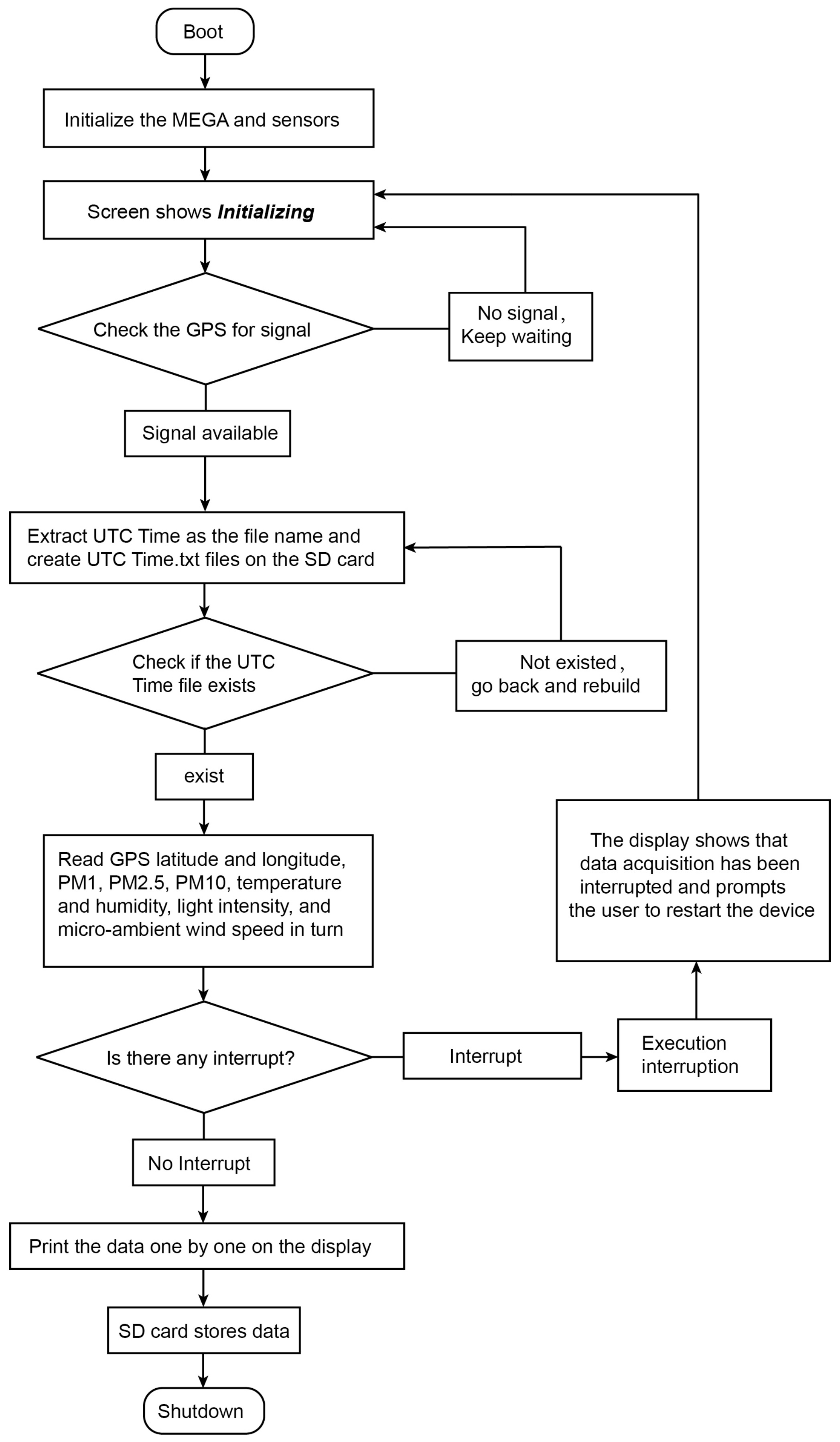
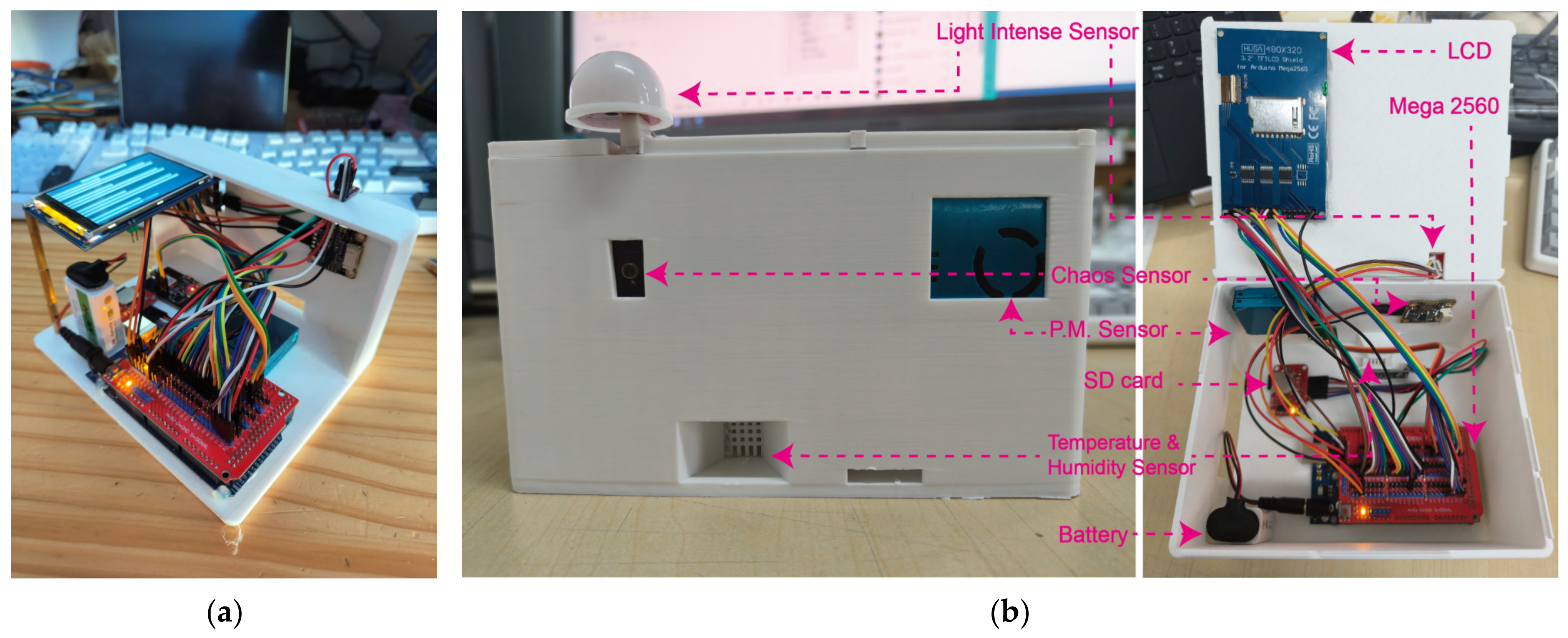

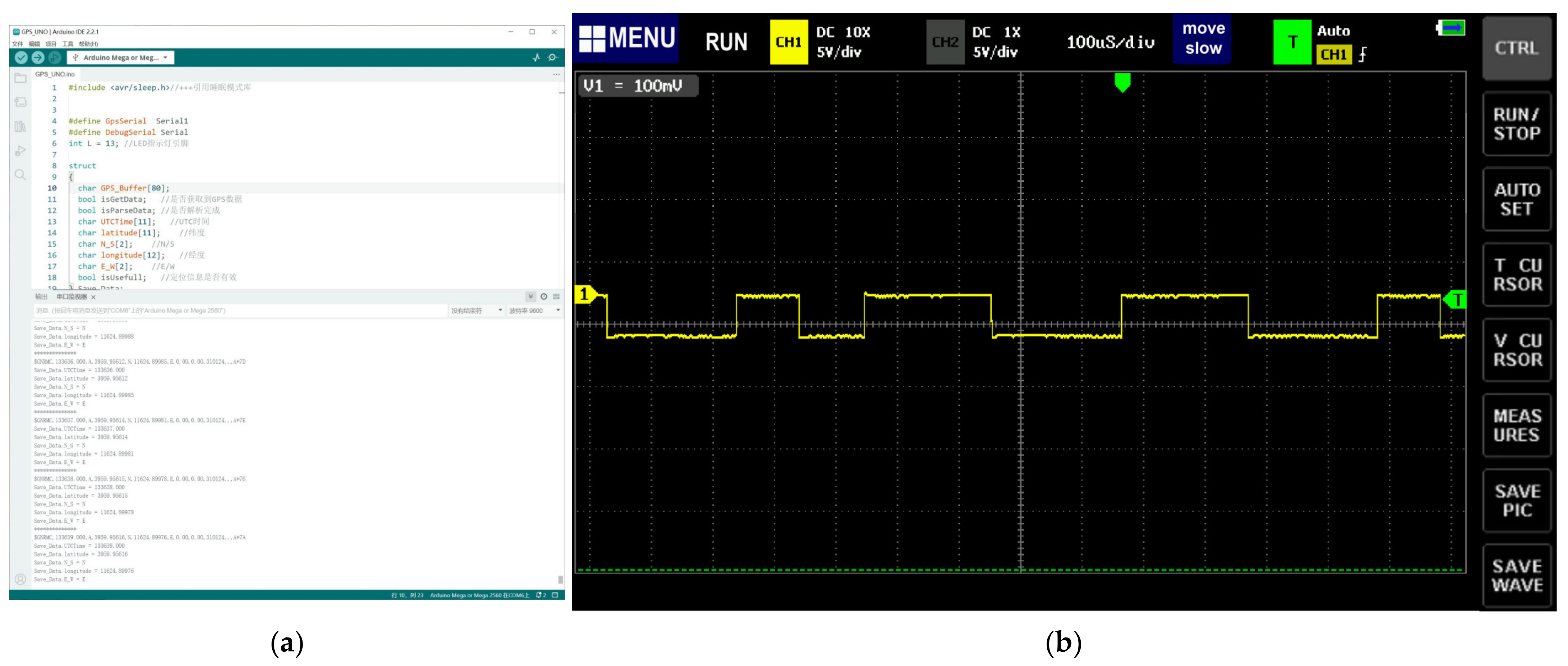





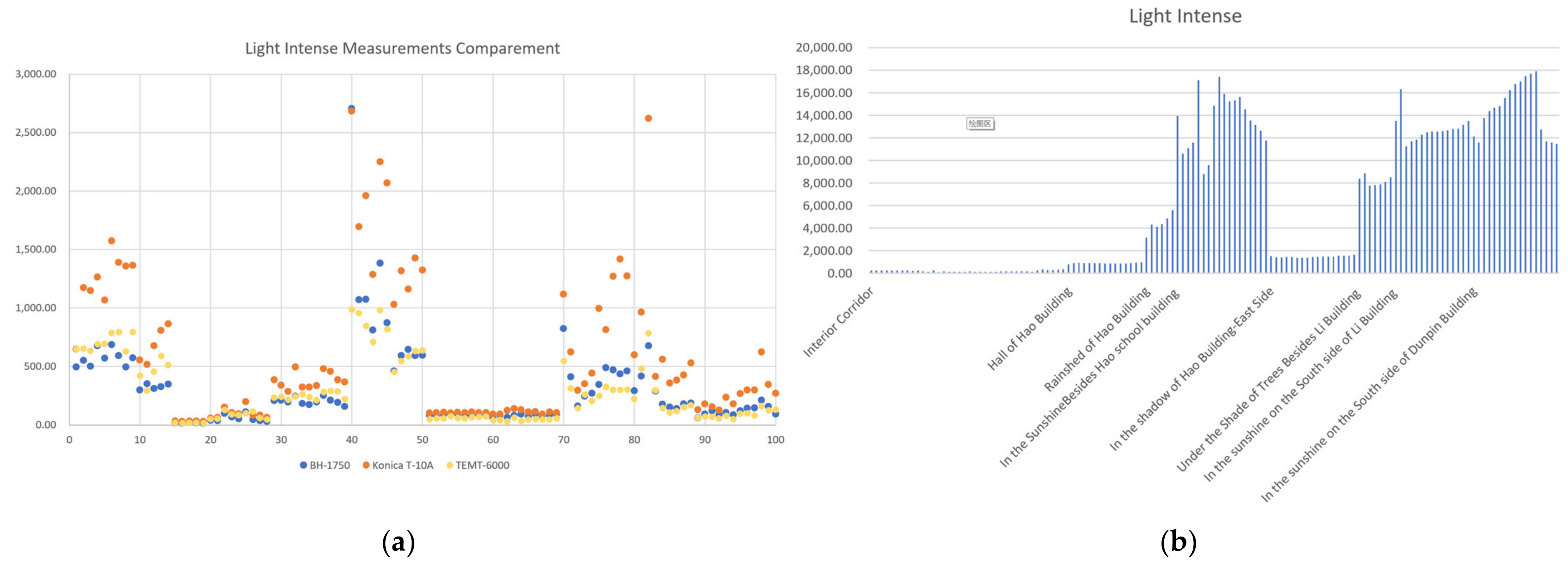




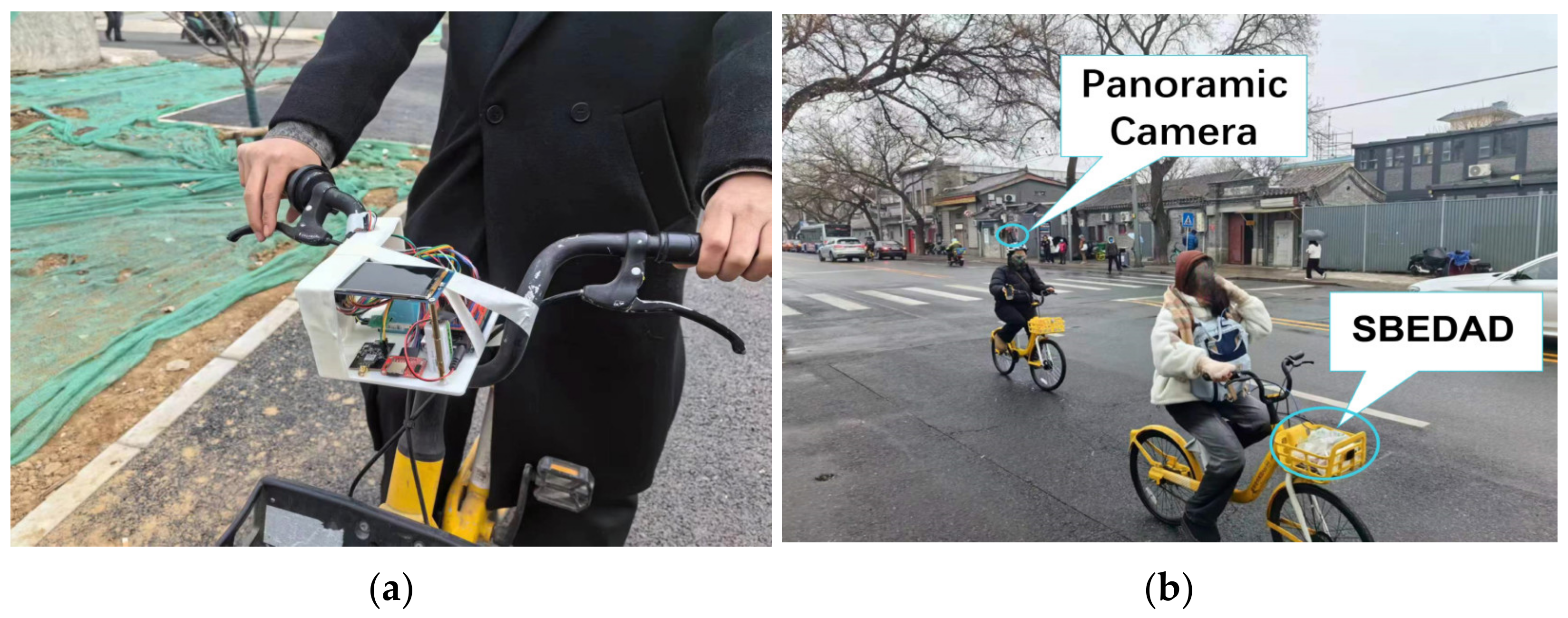
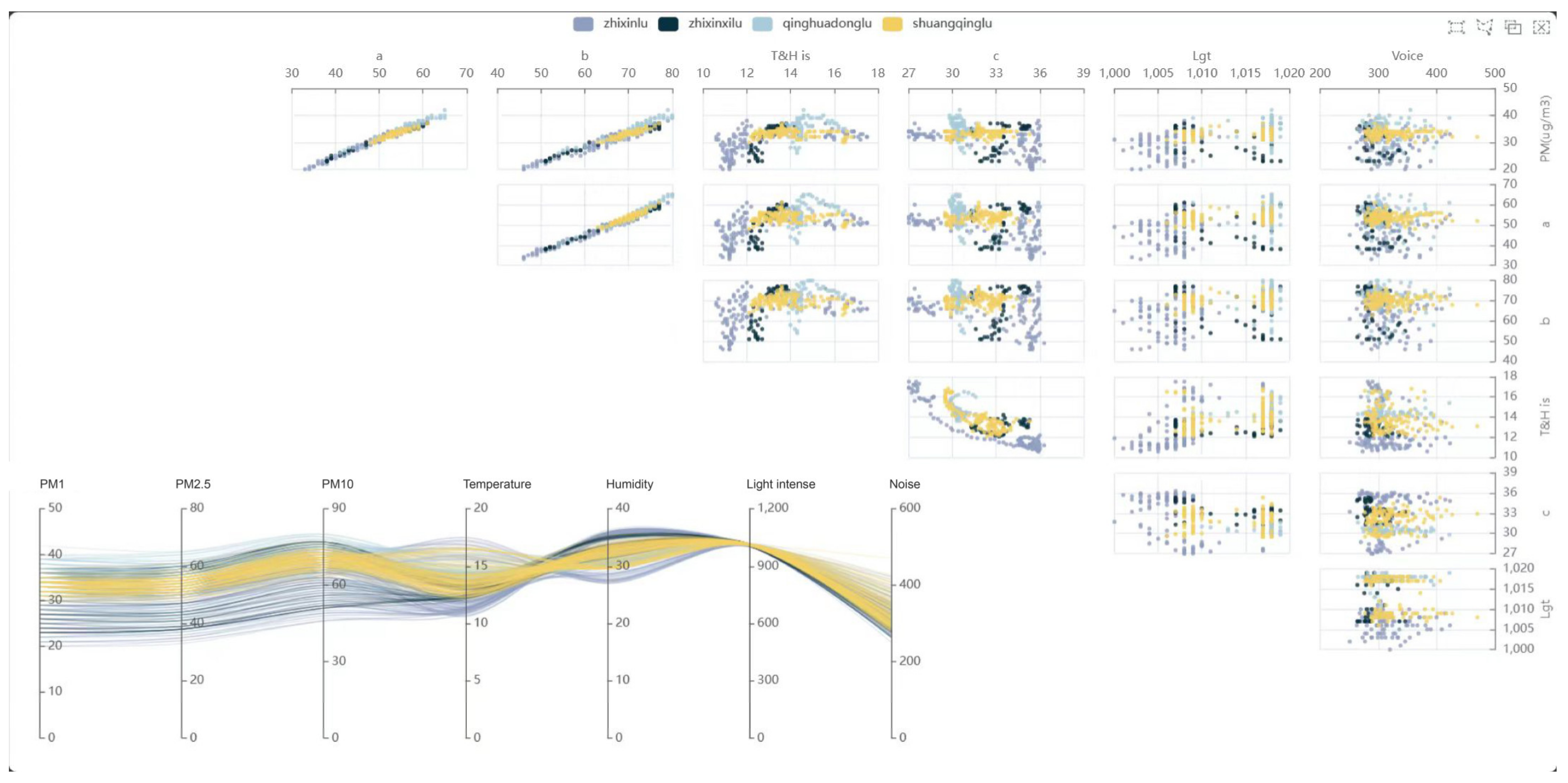
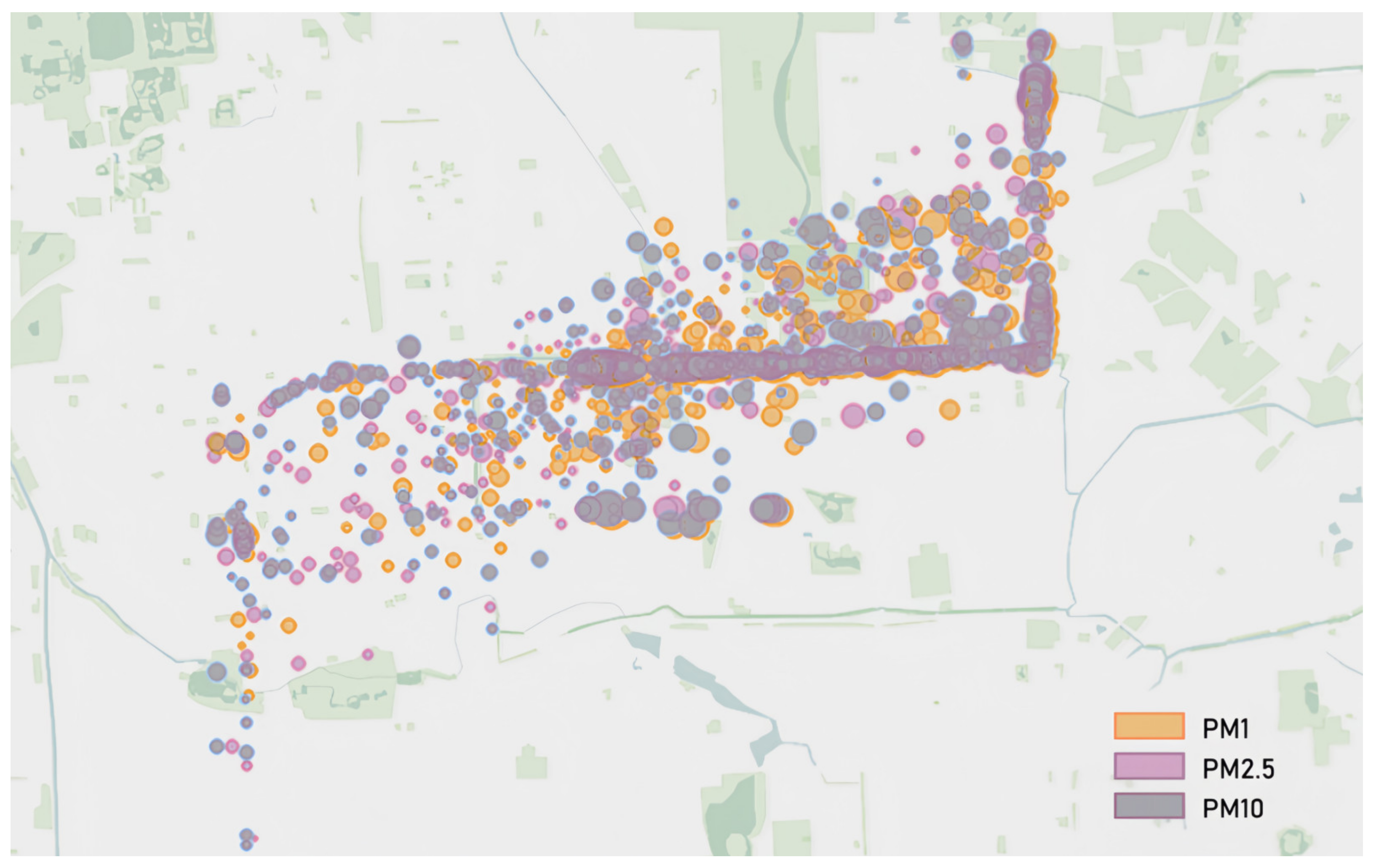
| Mega 2560 Specification Parameter | |
|---|---|
| Operating voltage | 5 V |
| Input voltage (recommended) | 7–12 V |
| Input voltage (limit) | 6–20 V |
| Digital I/O pins | 54 |
| Analog I/O pins | 16 |
| DC I/O pin | 40 mA |
| DC for 3.3 V pin | 50 mA |
| Flash memory | 256 KB |
| SRAM | 8 KB |
| EEPROM | 4 KB |
| Clock frequency | 16 MHz |
| Purpose | Type | Model | Response Time |
|---|---|---|---|
| Printed circuit board | Arduino | MEGA2560 | -- |
| Longitude and latitude | GPS and BDS | ATGM336H-5N | 0.1 ms |
| Temperature and humidity | Humidity and temperature | DHT22 | 10 ms |
| Air pollution | PM | Plantower G7003S | 100 ms |
| Light | Light sensor | TEMT6000 | 20 ms |
| Light sensor | BH1750 | 5 ms | |
| Noise | Voice sensor | Croco-Sound | 20 ms |
| Air flow | Air flow sensor | Air flow sensor | 10 ms |
| Status display | LCD | HX8357-B | |
| Data storage | SD | OV7670 | |
| Video record | Panoramic camera | Pilot One |
| Model | Nature | Commercial | Price |
|---|---|---|---|
| MEGA2560 | Obligatory | YES | 35.28 |
| ATGM336H-5N | Obligatory | YES | 10.93 |
| DHT22 | Obligatory | YES | 1.08 |
| Plantower G7003S | Obligatory | YES | 12.18 |
| TEMT6000 | Obligatory | YES | 0.90 |
| BH1750 | Obligatory | YES | 1.1 |
| Croco Sound | Obligatory | YES | 1.37 |
| Air flow sensor | Optional | YES | 6.64 |
| HX8357-B | Obligatory | YES | 1.38 |
| OV7670 | Obligatory | YES | 0.48 |
| PTQS1005 | Optional | YES | 69.16 |
| Heart beat rate sensor | Optional | YES | 1.51 |
| 3D-printed shell | Optional | No | 5 |
| Batteries | Obligatory | YES | 2.77 |
| Cable and welding | Obligatory | No | 1 |
| Switching button | Optional | YES | 1.11 |
| Resistor | Obligatory | YES | 0.1 |
| Model | Range | Error Precision | SBEDAD Accuracy |
|---|---|---|---|
| Temperature | 18–25 °C [44,45] | ±1 °C | ±0.5 °C |
| Humidity | 40–70% [44,45] | >1% | ±1% |
| PM | 0–500 μg/m3 [46] | ±25% | ±10–100 μg/m3 |
| Light | 10,000–18,000 Lux [47] | ±20% | >10 lux |
| Sound | 40–120 db [48] | ±5 db | 0–40 m/s |
| GPS | -- | -- | 2 m |
| Model | Nature |
|---|---|
| Manufacturer | Yahboom |
| Cold-start acquisition sensitivity | −148 dBm |
| Hot-start acquisition sensitivity | −156 dBm |
| Recapture sensitivity | −160 dBm |
| Tracking sensitivity | −162 dBm |
| Positioning accuracy | 2.5 m(CEP50) |
| Typical power consumption | 25 mA @3.3 V |
| Agreement | NMEA0183 |
| Maximum height | 8000 m |
| Maximum speed | 515 m/s |
| Operating temperature | −40 °C to + 85 °C |
| Size and weight | 10.1 mm × 9.7 mm × 2.4 mm, 0.6 g |
| DHT11 | DHT22 | UNI-T UT332+ | |
|---|---|---|---|
 |  |  | |
| Temperature range | 0 to 50 °C +/−2 °C | −40 to 80 °C +/−0.5 °C | −20 to 80 °C |
| Humidity range | 20 to 90% +/−5% | 0 to 100% +/−2% | 0 to 100% |
| Resolution | Humidity: 1% Temperature: 1 °C | Humidity: 0.1% Temperature: 0.1 °C | Humidity: 0.1% Temperature: 0.1 °C |
| Operating voltage | 3–5.5 V DC | 3–6 V DC | 3–5 V DC |
| Current supply | 0.5–2.5 mA | 1–1.5 mA | 0–10 A |
| Sampling period | 1 s | 2 s | 1 s |
| Price | USD 1 to 5 | USD 4 to 10 | USD 60 to 80 |
| Parameter | Indicator | Unit |
|---|---|---|
| Principle | Laser Scattering | --- |
| Measuring range of particles | 0.3~1.0; 1.0~2.5; 2.5~10 | µm |
| Effective range of concentration | 0~500 | µg/m3 |
| Maximum mass | ≥1000 | µg/m3 |
| Mass concentration resolution | 1 | µg/m3 |
| DC voltage | 4.5–5.5 | V |
| Working current | ≤100 | mA |
| Standby current | ≤200 | µA |
| operating temperature range | −10~+60 | °C |
| Operating humidity range | 0~99% | V |
| TEMT6000 | BH1750 | Konica T-10A | |
|---|---|---|---|
 |  |  | |
| Intense range | 0–1023 | 1–100,000 lx | 0.01–299,900 lx |
| Deviation | 1 | 1 lx | 0.01 lux |
| Operating voltage | 1.5–6 V DC | 1.8–4.5 V DC | 1.5 V DC |
| Operating temp | −10–100 °C | −10–85 °C | −20–55 °C |
| Current supply | 20 mA | 0.5–2.5 mA | 400 mA |
| Sampling period | 5 ms | 20 ms | 28 ms |
| Power dissipation | 100 mw | 260 mw | 244 mw |
| Price | USD 1 | USD 3 | USD 2000 |
| Yahboom | Noise App | |
|---|---|---|
 |  | |
| Intense range | 0–1023 | 0–140 dB |
| Deviation | ±1% | 0.1 dB |
| Operating voltage | 3.3–5 V DC | 0.8–1 V DC |
| Operating temperature | −40–100 °C | −10–85 °C |
| Current supply | 20 mA | 80 mA |
| Sampling period | 20 ms | 1000 ms |
| Power dissipation | 100 mw | 18–26 W |
| Price | USD 0.9 | USD 12 |
Disclaimer/Publisher’s Note: The statements, opinions and data contained in all publications are solely those of the individual author(s) and contributor(s) and not of MDPI and/or the editor(s). MDPI and/or the editor(s) disclaim responsibility for any injury to people or property resulting from any ideas, methods, instructions or products referred to in the content. |
© 2024 by the authors. Licensee MDPI, Basel, Switzerland. This article is an open access article distributed under the terms and conditions of the Creative Commons Attribution (CC BY) license (https://creativecommons.org/licenses/by/4.0/).
Share and Cite
Luo, C.; Hui, L.; Shang, Z.; Wang, C.; Jin, M.; Wang, X.; Li, N. Portable Arduino-Based Multi-Sensor Device (SBEDAD): Measuring the Built Environment in Street Cycling Spaces. Sensors 2024, 24, 3096. https://doi.org/10.3390/s24103096
Luo C, Hui L, Shang Z, Wang C, Jin M, Wang X, Li N. Portable Arduino-Based Multi-Sensor Device (SBEDAD): Measuring the Built Environment in Street Cycling Spaces. Sensors. 2024; 24(10):3096. https://doi.org/10.3390/s24103096
Chicago/Turabian StyleLuo, Chuanwen, Linyuan Hui, Zikun Shang, Chenlong Wang, Mingyu Jin, Xiaobo Wang, and Ning Li. 2024. "Portable Arduino-Based Multi-Sensor Device (SBEDAD): Measuring the Built Environment in Street Cycling Spaces" Sensors 24, no. 10: 3096. https://doi.org/10.3390/s24103096
APA StyleLuo, C., Hui, L., Shang, Z., Wang, C., Jin, M., Wang, X., & Li, N. (2024). Portable Arduino-Based Multi-Sensor Device (SBEDAD): Measuring the Built Environment in Street Cycling Spaces. Sensors, 24(10), 3096. https://doi.org/10.3390/s24103096









